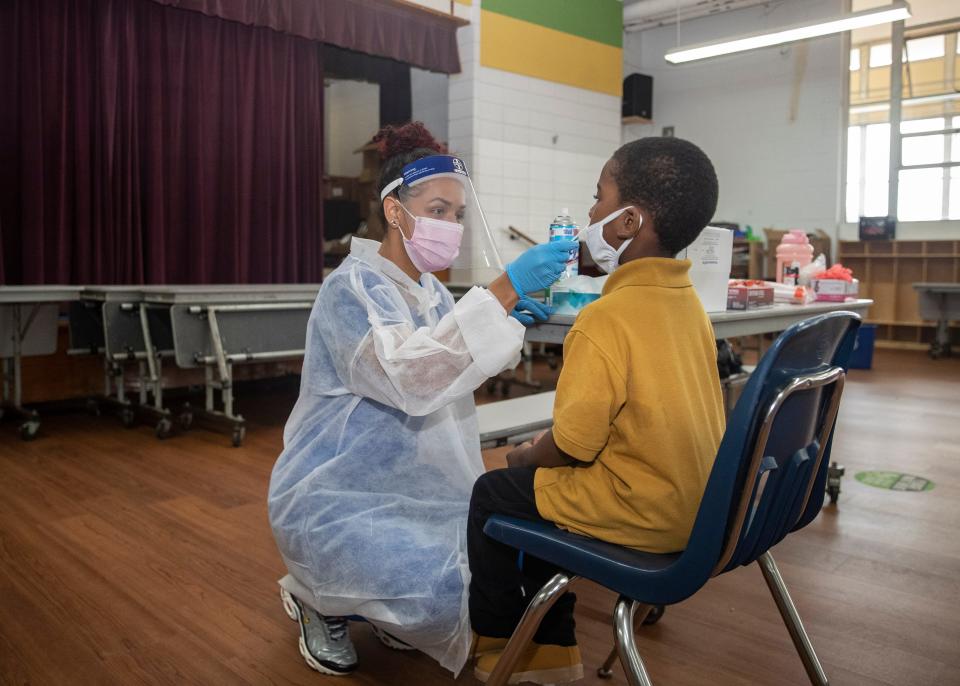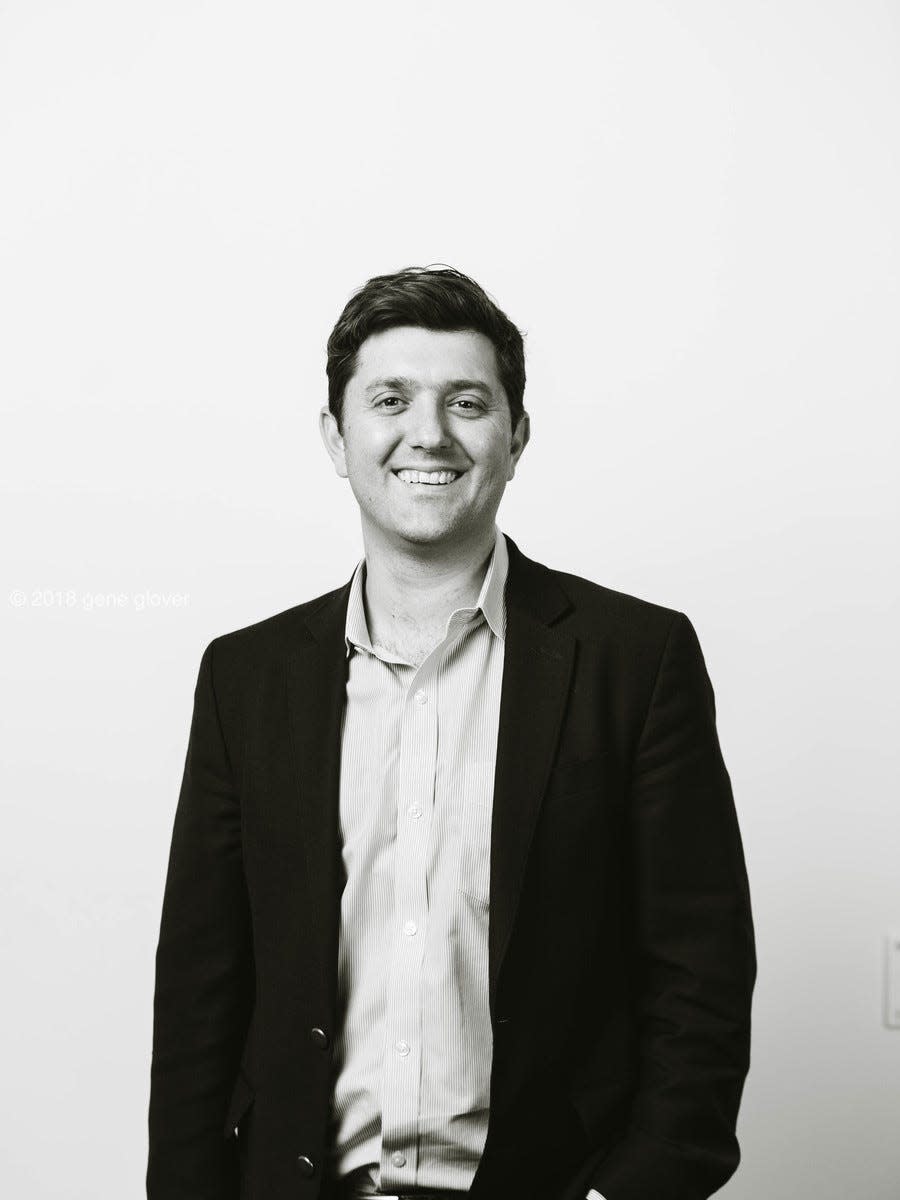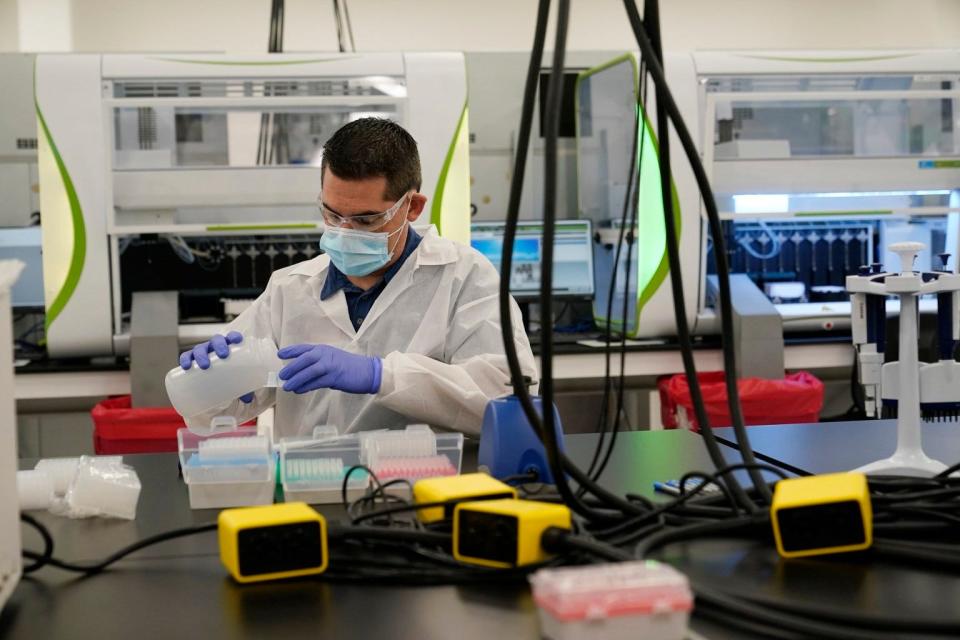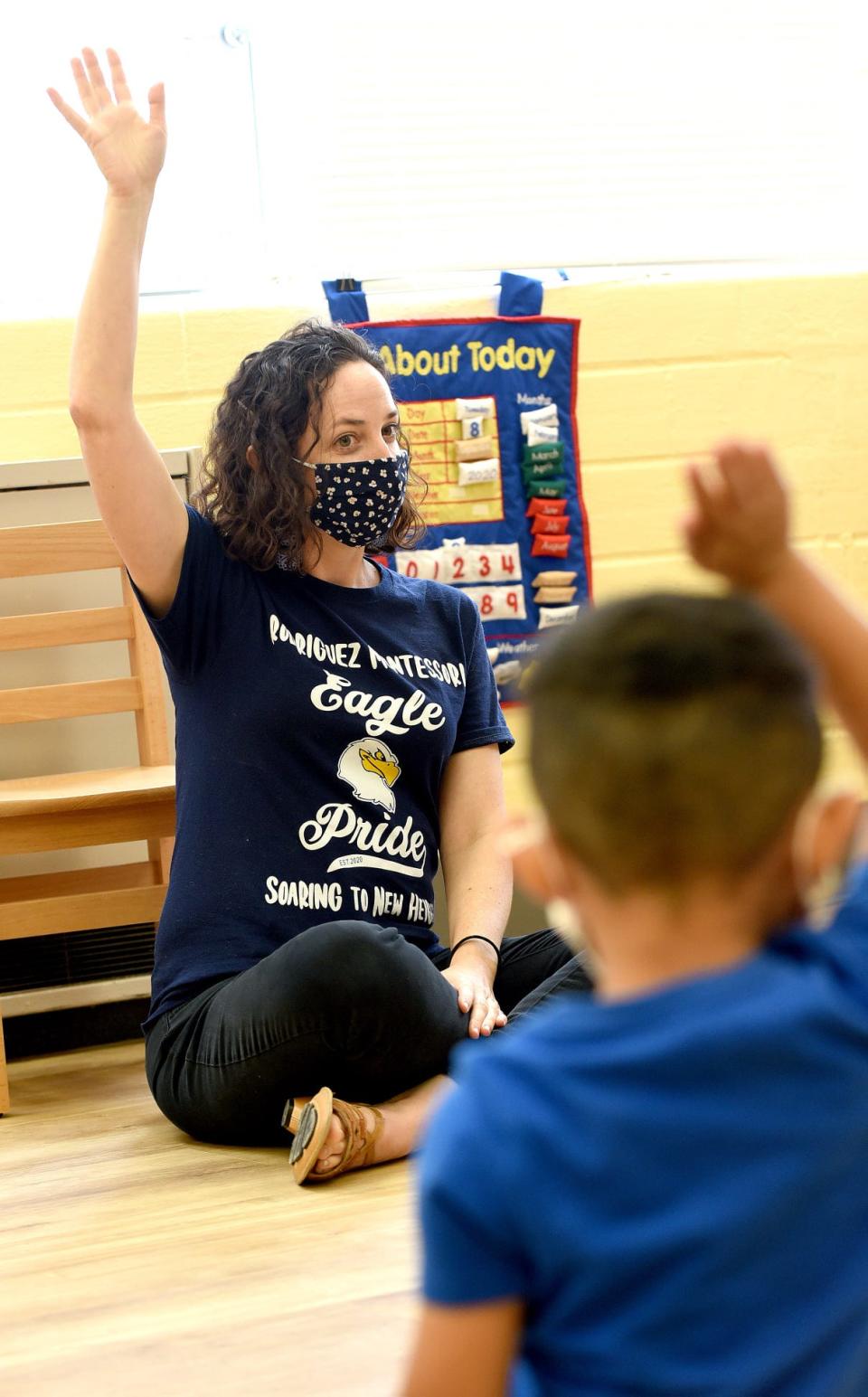Schools already testing students and staff for coronavirus say it's crucial to in-person class: 'It's worth it'
- Oops!Something went wrong.Please try again later.
Last November, McSwain Union Elementary School in Northern California was living two realities.
The school with about 850 students in Merced had a waiver to conduct in-person learning. But it couldn’t keep teachers in the building because of exposure to positive coronavirus cases.
In January, the school started testing teachers and then students for the virus, even if they weren't showing symptoms. Since then, regular, rapid antigen testing has caught five positive cases of staff members and one positive student who were either pre-symptomatic or asymptomatic, said Superintendent Roy Mendiola.
Those people and their close contacts were immediately sent home, but everyone else could stay in school.
“I’m not saying we should give up any of the other (in-school safety) protocols, but the antigen testing gives us an immediate response,” Mendiola said in a recent webinar.

As part of the push under President Joe Biden to reopen schools, the administration announced this week that it would make $10 billion available for K-12 schools to expand coronavirus screening of staff and students. Quick, rapid antigen tests that offer results in 15 minutes, like the ones used at McSwain Elementary, are likely to be adopted more broadly.
The Centers for Disease Control and Prevention this week released new recommendations in tandem with Biden's school-testing initiative. Biden administration officials say more details are coming, but the lack of national coordination so far has states and districts charting their own paths.
Schools that already set up testing regimes adopted different practices. Medical technology companies have raced to meet their needs with testing products and services. Health experts are split on what tests are best. And some staff and students' families have balked at testing.
Multiple companies make coronavirus tests, but the Food and Drug Administration has authorized only a handful of rapid tests that can be used without a doctor's prescription or medical oversight. Companies that make the least expensive versions have been unable to get FDA authorization.
It all adds up to schools emerging as the latest battleground for determining the best and smartest approaches to track the virus that causes COVID-19.
"It still needs to be coordinated," said Scott Becker, CEO of the Association of Public Health Laboratories. "You don’t want to just throw tests out there."

Testing is critical, but experts split on the details
Public health experts are optimistic widespread vaccination will drive case counts lower, but testing remains critical to track new cases and variants that might make the virus more contagious or deadly.
A growing number of medical experts say screening using cheap, rapid tests could help K-12 schools keep the virus in check as they return more staff and students to classrooms. Nursing homes have used such tests to quickly identify cases and protect vulnerable seniors and workers. And colleges in New England have adopted rapid tests to reopen safely in settings that would otherwise be ripe for COVID-19 spread.
"It's something that would have made a world of difference months ago," said Dr. Amesh Adalja, a senior scholar at Johns Hopkins Center for Health Security. "And it will make a world of difference if we can do it today."
Charity Dean, a physician who helped launch the California COVID-19 Testing Task Force last year, recommends schools use rapid tests twice a week to screen students and staff, because they're faster and cheaper than PCR tests.
"Fast and frequent testing is key," Dean said.
Increasing testing frequency from once every 14 days to once every two to three days significantly reduces the number of contagious cases in a population, Dean added, referencing studies.
But Tina Tan, a pediatrics professor at Northwestern University, said screening students without symptoms can be problematic, particularly with rapid antigen tests that might miss infections. Antigen tests, which detect proteins of the coronavirus, are less expensive and deliver results quickly but are generally less sensitive than PCR tests.
Rapid antigen tests "are probably not the best way if you’re going to test somebody, primarily because you’re looking at that one point in time,” said Tan, an Infectious Diseases Society of America board member. “It doesn’t tell you that the person may be incubating disease or whether the person is truly infected.”
On Friday, the CDC updated its school reopening guidance to lower physical distancing recommendations to 3 feet in classrooms. The changes also said weekly screenings of asymptomatic teachers and students is "particularly valuable" in communities where COVID-19 spread is moderate to high.
Students in high-risk sports in places with substantial to high transmission should be screened twice a week, the guidance says.
New CDC guidance: 3 feet instead of 6 feet apart in schools paves the way for more in-person instruction
Carole Johnson, Biden's coronavirus testing coordinator, said schools want resources to test so they can reopen.
"We know there are many schools that want that," Johnson said. "We know there are schools that have tried to do it and have struggled to have the resources to do it."

PCR testing in schools: How it works
New York City Public Schools is the largest district with mandatory coronavirus testing, which the teachers union pushed for in its reopening agreement. Students and staff are randomly selected for weekly PCR tests, and about 20% of each school's population is tested each month. Families and staff have to consent to testing to return to in-person learning.
As of March 16, the in-school virus positivity rate was .57%, according to the district. That's lower than the latest average percentage of people who tested positive citywide: 6.74%, according to the city.
Other districts in Maryland and Massachusetts have adopted pooled PCR testing. In that method, students in a class or pod swab their own noses and combine the sample, which is sent out for a PCR test. If the test does not find the virus in the pooled samples, the group is considered virus-free. Depending on the school's protocol, a positive result requires each person to be tested individually.
The new CDC guidance says pooled testing is "best used in situations where the number of positives is expected to be very low" because of the actions required after a positive result.
Ginkgo Bioworks, a Boston-based company, handles the pooled testing for Baltimore City Public Schools as part of a $5.7 million contract. CEO Jason Kelly said combining samples is efficient and cuts down on staffing needs because students can self-administer the test while a teacher watches. The program costs about $6 per student each week, he said.

The most recent data from Baltimore City schools shows 13 positive pooled test results out of 253 pods of students tested, according to the Baltimore Sun.
Massachusetts has a statewide contract with Ginkgo and the Broad Institute at Massachusetts Institute of Technology to make the same pooled testing available to all public schools. Education Commissioner Jeffrey Riley has said the state's elementary schools need to reopen full time by April 15.
Clark County Schools in Las Vegas has also adopted mandatory, random PCR testing, but only for staff. The district recently approved about $3.3 million in contracts for testing 10% to 20% of employees on a monthly basis, according to the Las Vegas Review-Journal.
Rapid antigen testing in schools: How it works
Other states and districts are relying on rapid antigen testing. In Delaware, 76 schools are using rapid antigen testing to catch asymptomatic cases. The tests come from Becton, Dickinson and Company, a New Jersey-based medical technology company.
In Utah, some public high schools are using Abbott Labs BinaxNow rapid antigen tests twice a month to screen student athletes and those in extracurricular activities. The tests are given to regular in-person learners if the number of virus case counts in a school grows too high. Students who refuse to test or who are positive go home to quarantine. Students with a negative result can stay in class.
“Some kids in the first semester had to spend 20 or 30 days at home quarantining,” said Lexi Cunningham, head of the Utah Schools Superintendents Association. “The majority of the kids were in a class with a kid with COVID, but they didn’t have it themselves."
It's been a "big lift," she added. “But people have said it’s worth it to keep kids in school."
In California, the state superintendent and governor's office just announced they're sending 3 million free rapid antigen tests to about two dozen high-needs districts – a move in the works before the new federal money for testing was announced.
Many of California's 11,000 districts have struggled to reopen for full-time instruction because of high rates of virus transmission and push back from teachers unions over safety concerns.
That makes the new federal money to expand testing more crucial than ever, state Superintendent Tony Thurmond said.
"It's an important part of how we're going to keep schools open, and businesses open," he said.

Screening programs helped two Texas districts stay open
School districts in Texas were under state orders this year to provide in-person learning, and at least two used expansive coronavirus screening as part of their safety protocols.
The San Antonio Independent School District conducts both PCR and rapid tests. Since January, the district has offered weekly PCR tests for asymptomatic staff working in-person. About 70% participate. A local nonprofit health organization, Community Labs, oversees the self-administered screenings.
High school students involved in extracurricular activities take rapid antigen tests, and middle-school students are about to do the same so they can resume sports and extracurriculars, said Toni Thompson, San Antonio's associate superintendent.
"Having quick access to results helps mitigate additional exposure because we're able to quickly isolate positive staff and students," Thompson said.
On-campus transmission has been negligible.. At the end of February the positivity rate in the schools was .8%, she added.

Across the state in El Paso, the Ysleta Independent School District offered in-person learning last fall for students with special needs, English learners and others who were disadvantaged. Ysleta began testing those students, some employees and athletes using the BinaxNOW rapid antigen tests.
Elsewhere, most large districts around the country were operating 100% virtually – and virus transmission in West Texas was raging. Local hospitals had more patients than available ICU beds. But a fall sports season and in-person learning for the limited groups of students continued at Ysleta.
The district completed more than 20,000 rapid tests last fall and less than 1% were positive. As the virus retreated, teachers agreed to return to class on Feb. 1 and schools reopened to students willing to undergo weekly health screenings.
Every Monday, the district completes about 18,000 tests on students and staff, said Superintendent Xavier De La Torre.
During a trip last week to district schools, it was "the first time I didn't see the anxiety and discomfort among employees and administrators," De La Torre said. "We're heading in the right direction."
This article originally appeared on USA TODAY: Does COVID testing in schools work? It helped these Texas districts

